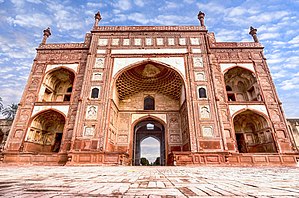Akbari Sarai
اکبری سرائے | |
 The Akbari Sarai features a monumental gateway that leads to the Tomb of Jahangir, and is richly embellished with pietra dura | |
 | |
| 31°37′21″N 74°17′59″E / 31.6225°N 74.2997°E | |
| Location | Lahore, Punjab, Pakistan |
|---|---|
| Type | Gateway |
| Completion date | 1637 |
The Akbari Sarai (
Etymology
The name can be translated as "Palace of Akbar". Abdul Hamid Lahori, court historian to the Emperor Shah Jahan, mentioned the building by the name Jilu Khana-e-Rauza, which means "attached court of the tomb", in his book the Padshahnama.[1]
Location
The sarai quadrangle is situated in the middle of the Jahangir, to the east, and the east of Asif Khan which lies to the west of the sarai.
History
Despite the name of the structure, Akbari Sarai was begun during the reign of Islam Shah Suri in the mid 1550s, and not during the reign of the Mughal Emperor Akbar.[3] The mosque at the sarai dates from the Suri period, though the cells which line the complex, and its gateways,[2] date from the Shah Jahan period in the mid 1600s.[3]
The sarai served as both a station for wayfarers, and also a mail station known as a dāk chowkī.[2] The sarai was administered by an official known as a Shāhnā with several assistant caretakers.[2] The 180 cells around the courtyard were used as living areas and storage spaces for luggage, weapons, and other gear carried by visitors to the tombs.[4] Fodder for animals, hot and cold water, and bed steads were provided free of charge.[2] The sarai also had a physician, as well as a resident baker,[2] and a water well located outside of the walls of the sarai. As with many sarais, a small bazaar may have run between each gate.[2]
Maharajah
Architecture

The sarai is in the form of an oblong quadrangle, which covers a total area of 12 acres.[6] The sarai measures 797 feet by 610 feet.[2] The courtyard of the sarai complex is flanked on all sides by a raised terrace where rows of 180 cells known as khanaha are located with a veranda and a common open passage.
The corners of the sarai are flanked by towers. Tower chambers are the most elaborate of all the sarai's cells, and feature and elliptical hall in front with a veranda, with an octagonal room in the back.[3]
The palace has two large gateways in the
To the west of the palace in the middle of the cell rows is a mosque with three domes. It is clad in red sandstone with decorations. The interior of the mosque was probably once embellished with frescoes and ghalib kari as well.
Conservation
The Akbari Sarai, along with the Tombs of Jahangir and Asif Khan, were inscribed on the tentative list of UNESCO World Heritage Sites in 1993.[7]
Gallery
-
Akbari Sarai from distance
-
Detail of the structure's pietra dura
-
180 small cells line the walls of the saray
-
Muqarnas decorate the top the main archway
-
The building is richly embellished with pietra dura
See also
- Tomb of Asif Khan
- Tomb of Jahangir
- Tomb of Muhammad Iqbal
- Tomb of Nur Jahan
- List of parks and gardens in Lahore
- List of parks and gardens in Pakistan
References
- ^ a b Khan, Mohammad Waliullah (1973). Lahore and Its Important Monuments. Department of Archaeology and Museums, Ministry of Education, Government of Pakistan. Retrieved 14 September 2017.
- ^ ISBN 9781571812223. Retrieved 14 September 2017.
- ^ ISBN 9781571812216. Retrieved 14 September 2017.
- ^ Akbari Serai, Lahore, Pakistan orientalarchitecture.com Retrieved April 23, 2021.
- ^ Rogers Kolachi Khan & Associates Pvt. Ltd. (February 2011). "Site Conservation Assessment Report: Jahangir's Tomb Complex, Lahore, Pakistan" (PDF). Global Heritage Fund. Global Heritage Fund. Retrieved 14 September 2017.
- ^ Ahmad, Zulfiqar (1988). Notes on Punjab and Mughal India: Selections from Journal of the Punjab Historical Society. Sang-e-Meel Publications. Retrieved 14 September 2017.
- ^ "Tombs of Jahangir, Asif Khan and Akbari Sarai, Lahore". UNESCO World Heritage Centre. Retrieved 2013-12-03.
![]() Media related to Akbari Sarai at Wikimedia Commons
Media related to Akbari Sarai at Wikimedia Commons







